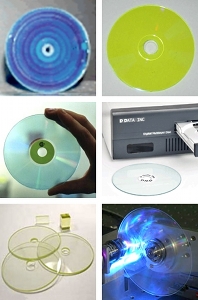| Optical discs |
|---|
| |
3D optical data storage is any form of optical data storage in which information can be recorded or read with three-dimensional resolution (as opposed to the two-dimensional resolution afforded, for example, by CD). [1] [2]
| Optical discs |
|---|
| |
3D optical data storage is any form of optical data storage in which information can be recorded or read with three-dimensional resolution (as opposed to the two-dimensional resolution afforded, for example, by CD). [1] [2]
The origins of the field date back to the 1950s, when Yehuda Hirshberg developed the photochromic spiropyrans and suggested their use in data storage. [3] In the 1970s, Valerii Barachevskii demonstrated [4] that this photochromism could be produced by two-photon excitation, and at the end of the 1980s Peter M. Rentzepis showed that this could lead to three-dimensional data storage. [5]
Second-harmonic generation has been demonstrated as a method to read data written into a poled polymer matrix. [6]
Optical coherence tomography has also been demonstrated as a parallel reading method. [7]
